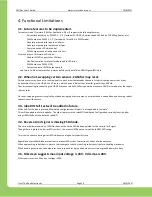
CANifier
User’s
Guide www.ctr-electronics.com 10/8/2017
Cross The Road Electronics Page 19 10/8/2017
4. Functional Limitations
4.1. Future features to be implemented.
Current version of firmware (CANifier-Application-0.9.crf) supports the following
features…
-
Pulse width decoding on PWM 0, 1, 2, 3. (Tested with LIDAR v3, various hobby RC Radios, CTRE Mag Sensor, etc.).
-
PWM output on PWM 0, 1, 2. (Tested with Talon SRX in PWM mode).
-
General purpose digital inputs on all pins.
-
General purpose digital outputs on all pins.
-
Common anode LED strip control.
-
PWM outputs have a fixed period of 4.2ms.
Future versions of firmware will include…
-
General I2C/SPI support over CAN bus.
-
NeoPixel compliant protocol for addressable LED strips.
-
PWM output on PWM 3 (CS)
-
Custom control of PWM output period.
… and future
CAN bus features that communicate directly with Talon SRXs/Pigeon-IMUs/etc.
4.2. When hot-swapping certain sensors, CANifier may reset.
Certain sensors may have an in-rush (on-boot) current draw that exceeds the sensor
’
s typical continuous current draw.
An example of this is the LIDAR-Lite V3 sensor, which has an initial current draw far greater than 500 mA.
Thus, disconnecting/reconnecting the LIDAR Lite sensor while CANifier is powered may cause CANifier to reboot as the supply
rail may reset.
Since hot-swapping sensors is typically not done during robotic movement, no workaround is needed beyond ensuring robust
connectivity with sensors.
4.3. roboRIO Self-test will be added in future.
When Self-Test button is pressed, Web-
based configuration will report “not supported in firmware”.
This will be added in a future update. The other features in the roboRIO Web-Based Configuration currently function after
using HERO LifeBoat to update the roboRIO.
4.4. Reverse Limit signal is missing ESD diode.
The current hardware version of CANifier does not have the ESD diode populated for the reverse limit signal.
Though there is protection (series 22
Ω resistor
), this means LIMR does not meet the full 8KV ESD rating.
This is only a concern during direct ESD strikes occurring on this specific trace.
Regardless, users should take precautions to prevent ESD strikes to electronics under all circumstances.
When approaching robot chassis, be sure to discharge to robot by touching robot chassis before handling electronics.
When handling electronics, take measures to ensure handler is grounded via a wrist strap or grounded work surface.
4.5. Silkscreen suggests max input voltage is 33V. Vdd-max is 28V.
Silkscreen is incorrect. Max input voltage is 28V.



































